Papers by Benjamin G Purzycki
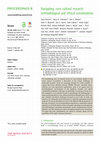
Proceedings of the Royal Society B: Biological Sciences, 2020
The intensifying pace of research based on cross-cultural studies in the social sciences necessit... more The intensifying pace of research based on cross-cultural studies in the social sciences necessitates a discussion of the unique challenges of multi-sited research. Given an increasing demand for social scientists to expand their data collection beyond WEIRD (Western, educated, industrialized, rich and democratic) populations, there is an urgent need for transdisciplinary conversations on the logistical, scientific and ethical considerations inherent to this type of scholarship. As a group of social scientists engaged in cross-cultural research in psychology and anthropology, we hope to guide prospective cross-cultural researchers through some of the complex scientific and ethical challenges involved in such work: (a) study site selection, (b) community involvement and (c) culturally appropriate research methods. We aim to shed light on some of the difficult ethical quandaries of this type of research. Our recommendation emphasizes a community-centred approach, in which the desires ...
The Cognitive Science of Religion, 2019

Many aspects of religious rituals suggest they provide adaptive benefits. Studies across societie... more Many aspects of religious rituals suggest they provide adaptive benefits. Studies across societies consistently find that investments in ritual behaviour return high levels of cooperation. Another line of research finds that alloparental support to mothers increases maternal fertility and improves child outcomes. Although plausible, whether religious cooperation extends to alloparenting and/or affects child development remains unclear. Using 10 years of data collected from the Avon Longitudinal Study of Parents and Children (ALSPAC), we test the predictions that church attendance is positively associated with social support and fertility (<i>N</i> = 8,207 to <i>N</i> = 8,209), and that social support is positively associated with fertility and child development (<i>N</i> = 1,766 to <i>N</i> = 6,561). Results show that: (i) relative to not attending, church attendance is positively related to a woman's social network support and aid from co-religionists, (ii) aid from co-religionists is associated with increased family size, while (iii) fertility declines with extra-religious social network support. Moreover, while extra-religious social network support decreased over time, co-religionist aid remained constant. These findings suggest that religious and secular networks differ in their longevity and have divergent influences on a woman's fertility. We find some suggestive evidence that support to mothers and aid from co-religionists is positively associated with a child's cognitive ability at later stages of development. Findings provide mixed support for the premise that ritual, such as church attendance, is part of a strategy that returns the high levels of support, fertility and improved child outcomes. Identifying the diversity and scope of cooperative breeding strategies across global religions presents an intriguing new horizon in the evolutionary study of religious systems.This article is part of the theme issue 'Ritual renaissance: new insights into the most human of behaviours'.
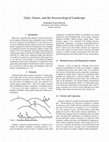
The social sciences have long recognized a relationship between religion and social ecology. Upon... more The social sciences have long recognized a relationship between religion and social ecology. Upon closer inspection, religious systems not only correspond to important features of a society’s social ecology, but also appear to directly address these features. In this article, we examine the prospect that these salient features may be framed as game theoretical dilemmas and argue that contemporary approaches that emphasize cognition and/or social learning at the expense of social ecology are inadequate in accounting for cross-cultural variation in religious expression. Using ethnographic examples, we show that religions alleviate the costs of such dilemmas in a variety of ways by: 1) fostering beliefs that motivate and sustain beneficial practices; 2) incentivizing cooperative ventures; 3) encouraging ritual performances that minimize costly conflicts and bolster territorial conventions; 4) providing institutional forums to coordinate resource distributions; and 5) maintaining import...
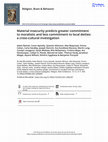
Religion Brain & Behavior, 2022
The existential security hypothesis predicts that in the absence of more successful secular insti... more The existential security hypothesis predicts that in the absence of more successful secular institutions, people will be attracted to religion when they are materially insecure. Most assessments, however, employ data sampled at a state-level with a focus on world religions. Using individual-level data collected in societies of varied community sizes with diverse religious traditions including animism, shamanism, polytheism, and monotheism, we conducted a systematic cross-cultural test (N = 1820; 14 societies) of the relationship between material insecurity (indexed by food insecurity) and religious commitment (indexed by both beliefs and practices). Moreover, we examined the relationship between material security and individuals' commitment to two types of deities (moralistic and local), thus providing the first simultaneous test of the existential security hypothesis across coexisting traditions. Our results indicate that while material insecurity is associated with greater commitment to moralistic deities, it predicts less commitment to local deity traditions.
Religion, Brain & Behavior , 2022
Scholars of religion have long sought to explain the persistent finding that women tend to report... more Scholars of religion have long sought to explain the persistent finding that women tend to report greater religiosity than men. However, the size of this "gender gap" may depend on the measure of religiosity employed,
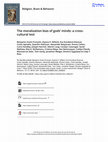
Religion, Brain & Behavior, 2022
There are compelling reasons to expect that cognitively representing any
active, powerful deity m... more There are compelling reasons to expect that cognitively representing any
active, powerful deity motivates cooperative behavior. One mechanism
underlying this association could be a cognitive bias toward generally
attributing moral concern to anthropomorphic agents. If humans
cognitively represent the minds of deities and humans in the same way,
and if human agents are generally conceptualized as having moral
concern, a broad tendency to attribute moral concern—a “moralization
bias”—to supernatural deities follows. Using data from 2,228 individuals
in 15 different field sites, we test for the existence of such a bias. We
find that people are indeed more likely than chance to indicate that
local deities care about punishing theft, murder, and deceit. This effect
is stable even after holding beliefs about explicitly moralistic deities
constant. Additionally, we take a close look at data collected among
Hadza foragers and find two of their deities to be morally interested.
There is no evidence to suggest that this effect is due to direct
missionary contact. We posit that the “moralization bias of gods’ minds”
is part of a widespread but variable religious phenotype, and a
candidate mechanism that contributes to the well-recognized
association between religion and cooperation.
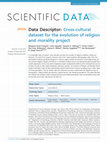
Scientific Data, 2016
A considerable body of research cross-culturally examines the evolution of religious traditions, ... more A considerable body of research cross-culturally examines the evolution of religious traditions, beliefs and behaviors. The bulk of this research, however, draws from coded qualitative ethnographies rather than from standardized methods specifically designed to measure religious beliefs and behaviors. Psychological data sets that examine religious thought and behavior in controlled conditions tend to be disproportionately sampled from student populations. Some cross-national databases employ standardized methods at the individual level, but are primarily focused on fully market integrated, state-level societies. The Evolution of Religion and Morality Project sought to generate a data set that systematically probed individual level measures sampling across a wider range of human populations. The set includes data from behavioral economic experiments and detailed surveys of demographics, religious beliefs and practices, material security, and intergroup perceptions. This paper describes the methods and variables, briefly introduces the sites and sampling techniques, notes inconsistencies across sites, and provides some basic reporting for the data set.
Using data collected in the Tyva Republic, the present work sheds light on the dynamic nature of ... more Using data collected in the Tyva Republic, the present work sheds light on the dynamic nature of religious cognition. In doing so, it reveals important patterns in the representation and distribution of religious concepts in this remote corner of the globe. This paper first introduces a cognitive ecological account of religion by examining human representational structures and how they interact with features of the natural environment. It then discusses this interaction in light of some Tyvan folktales followed by a report of how Tyvan spirit-masters’ forms correspond to type of landmark; anthropomorphic spirit-masters are associated with regions whereas zoomorphic spirits are associated with discrete resources. It concludes by highlighting a number of important questions that emerge from a cognitive ecological view of religious concepts.

There are compelling reasons to expect that cognitively representing any active, powerful deity m... more There are compelling reasons to expect that cognitively representing any active, powerful deity motivates cooperative behavior. One mechanism underlying this association could be a cognitive bias toward generally attributing moral concern to anthropomorphic agents. If humans cognitively represent the minds of deities and humans in the same way, and if human agents are generally conceptualized as having moral concern, a broad tendency to attribute moral concern—a “moralization bias”—to supernatural deities follows. Using data from 2,228 individuals in 15 different field sites, we test for the existence of such a bias. We find that people are indeed more likely than chance to indicate that local deities are concerned with punishing theft, murder, and deceit. This effect is stable even after holding constant the effects of beliefs about explicitly moralistic deities. Additionally, we take a close look at data collected among Hadza foragers and find two of their deities to be morally in...
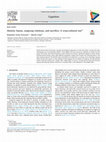
Cognition
Identity fusion theory has become a popular psychological explanation of costly self-sacrifice. I... more Identity fusion theory has become a popular psychological explanation of costly self-sacrifice. It posits that while maintaining one's own individual identity, a deep affinity with one's group can contribute to sacrifice for that group. We test this and related hypotheses using a behavioral economic experiment designed to detect biased, self-interested favoritism among eight different populations ranging from foragers and horticulturalists to the fully market-integrated. We find that while individuals favor themselves on average, those with higher ingroup fusion sacrifice more money to other members of their ingroup who are unable to reciprocate. We also find that positive outgroup relations has a similar effect. Additionally, we assess a recently-posited interaction between ingroup and outgroup relations and show no consistent effect at the individual or sub-sample levels.
Current Anthropology, 2016
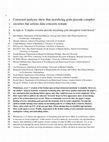
Whitehouse, et al.’s creation of the Seshat open archaeo-historical databank is laudable. However... more Whitehouse, et al.’s creation of the Seshat open archaeo-historical databank is laudable. However, the authors’ analysis methods, treatment of missing data, and source quality undermine the paper’s key conclusion that moralizing deities appear only after rapid increases in social complexity. First, their report fails to address the inherent ‘forward’ biases in first appearance dates of moralizing gods in the archaeo-historical record. When we minimally correct for this, the paper’s major finding reverses: moralizing gods precede the dramatic rises in social complexity. Second, the authors handle missing observations on moralizing gods by re-coding them as known absences. These values make up 61% of all outcome data. When missing data are handled appropriately, their result again reverses. Finally, inspections of the Seshat coding reveal systematic inaccuracies, inadequate vetting, and misleading claims.

Identify fusion theory has become a popular psychological explanation of costly self-sacrifice, wi... more Identify fusion theory has become a popular psychological explanation of costly self-sacrifice, with recent work positing that an interaction between negative outgroup relations and fusion with one’s ingroup which would lead to sacrificial behavior that benefits the ingroup. We test this hypothesis using a behavioral economic experiment designed to detect biased, self-interested favoritism among eight different populations ranging from foragers and horticulturalists to the fully market-integrated. We find that while individuals favor themselves on average, those with higher ingroup fusion sacrifice more money to others. However, the posited negative interaction between ingroup and outgroup relations shows no consistent effects at the individual or population levels because outgroup fusion also predicts sacrificing an opportunity to take more money. We conclude by suggesting that the fusion scale measures generalized sociability and/or is not necessarily able to precisely capture outgroup ho...
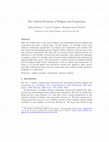
Since the earliest days of the social sciences, the relationship between religion and cooperation... more Since the earliest days of the social sciences, the relationship between religion and cooperation has been a central topic. In this chapter, we critically review some cultural evolutionary perspectives on religion and cooperation and consider how they frame the relationships among religious beliefs, behaviors, and the moral rules that motivate cooperation. We then offer an account of how religious systems can contribute to the stability of social life more generally, with cooperative dilemmas occupying a subset of a broader range of socioecological challenges that supernatural appeals might help resolve. We also provide a critical overview of popular methods used throughout much of the contemporary work on religion and cooperation. In doing so, we provide useful ways forward for testing how appeals to gods, spirits, and other supernatural forces can, in at least some cases, address locally important challenges to cooperation.
The International Journal for the Psychology of Religion
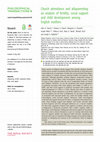
Philosophical Transactions of the Royal Society B: Biological Sciences
Many aspects of religious rituals suggest they provide adaptive benefits. Studies across societie... more Many aspects of religious rituals suggest they provide adaptive benefits. Studies across societies consistently find that investments in ritual behaviour return high levels of cooperation. Another line of research finds that alloparental support to mothers increases maternal fertility and improves child outcomes. Although plausible, whether religious cooperation extends to alloparenting and/or affects child development remains unclear. Using 10 years of data collected from the Avon Longitudinal Study of Parents and Children (ALSPAC), we test the predictions that church attendance is positively associated with social support and fertility ( n = 8207 to n = 8209), and that social support is positively associated with fertility and child development ( n = 1766 to n = 6561). Results show that: (i) relative to not attending, church attendance is positively related to a woman's social network support and aid from co-religionists, (ii) aid from co-religionists is associated with increa...
Religion, Brain & Behavior
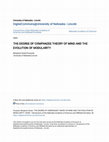
Whether or not chimpanzees have the ability to mentally represent others' mental states or theory... more Whether or not chimpanzees have the ability to mentally represent others' mental states or theory of mind (ToM) has yet to be definitively established. This results from three problems. First, modular theory of mind accounts lead researchers to adopt an either/or approach to psychological faculties which obfuscates both within-and across-species variability. Second, present research continues to rely on the continued trend to polarize nature and nurture. Third, the bulk of the work compares humans with chimpanzees rather than looking at the entire range of primate species. I propose "degree approach" by way of the Integrated Causal Model which particularizes the key components to ToM while maintaining the tenets of modularity theory. According to this account, while chimpanzees may not have a ToM that is equal to our own, they nevertheless exhibit behaviors that are indeed indicative of having one as illustrated by comparison to other extant primate research.

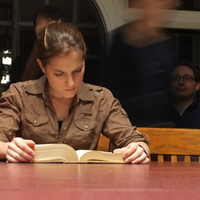

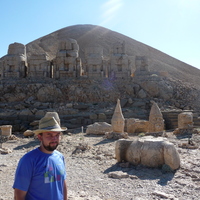






Uploads
Papers by Benjamin G Purzycki
active, powerful deity motivates cooperative behavior. One mechanism
underlying this association could be a cognitive bias toward generally
attributing moral concern to anthropomorphic agents. If humans
cognitively represent the minds of deities and humans in the same way,
and if human agents are generally conceptualized as having moral
concern, a broad tendency to attribute moral concern—a “moralization
bias”—to supernatural deities follows. Using data from 2,228 individuals
in 15 different field sites, we test for the existence of such a bias. We
find that people are indeed more likely than chance to indicate that
local deities care about punishing theft, murder, and deceit. This effect
is stable even after holding beliefs about explicitly moralistic deities
constant. Additionally, we take a close look at data collected among
Hadza foragers and find two of their deities to be morally interested.
There is no evidence to suggest that this effect is due to direct
missionary contact. We posit that the “moralization bias of gods’ minds”
is part of a widespread but variable religious phenotype, and a
candidate mechanism that contributes to the well-recognized
association between religion and cooperation.
active, powerful deity motivates cooperative behavior. One mechanism
underlying this association could be a cognitive bias toward generally
attributing moral concern to anthropomorphic agents. If humans
cognitively represent the minds of deities and humans in the same way,
and if human agents are generally conceptualized as having moral
concern, a broad tendency to attribute moral concern—a “moralization
bias”—to supernatural deities follows. Using data from 2,228 individuals
in 15 different field sites, we test for the existence of such a bias. We
find that people are indeed more likely than chance to indicate that
local deities care about punishing theft, murder, and deceit. This effect
is stable even after holding beliefs about explicitly moralistic deities
constant. Additionally, we take a close look at data collected among
Hadza foragers and find two of their deities to be morally interested.
There is no evidence to suggest that this effect is due to direct
missionary contact. We posit that the “moralization bias of gods’ minds”
is part of a widespread but variable religious phenotype, and a
candidate mechanism that contributes to the well-recognized
association between religion and cooperation.
systems. Drawing from a wealth of ethnographic and experimental evidence, the authors situate religious traditions within their local socioecological contexts, showing how these systems adaptively respond to economic, environmental, and health challenges. Based in the evolutionary, cognitive, and anthropological sciences, Religion Evolving offers a holistic approach that attends to the complex, interacting features of religious systems.